Editorial
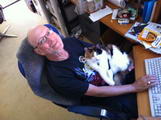
Putting the monthly edition of Model Engine News together takes a while and is frequently slowed further by circumstances, like having a monster cat decide to assist with the typing. Her name is Kali and as far as we can tell, she has never been bothered by the merest hint of a single thought in her entire life. In that regard she is totally unlike the pair who change her kitty litter, and fill her food bowl. As "self-funded retirees", we are frequently bothered by thoughts, principally related to the plummeting interest rate! Even so, we consider ourselves lucky to live "Down-under"—one of the few countries whose economy is running quite nicely thank you very much, and which managed to come through the Global Financial Crisis essentially unscathed. If this is lucky, sure makes me feel for others. Based on what we hear and read about conditions overseas, we hope there's a corner to be turned not too far away.
Autumn is now yielding to winter here at 27.46° South. Just last weekend, temperatures fell as low as 16°C overnight, so the fire got lit! For those who wonder how I'm getting on with my little inoperable prostate condition, life is good. I feel totally normal and most of the physical condition which I lost during three weeks in hospital has been regained. My last PSA count was 110, considerably better than the 800 odd of a year ago, though my doctor is somewhat at a loss to explain why as I've not been on any treatment for about six months. I'd like to say it's the power of positive thinking, but as an ex-scientist type, I have to conclude that everything has an explanation, even if we don't know what it is, yet.
When I started work on the May issue of MEN just over a week before my self imposed first of the month deadline, I was wondering how I was going to fill it. As usual when this happens, lots of things emerged from the woodwork that I hope you find of interest. We are also close to ready on a BIG revision to the ED Story. Adrian Duncan has yet another part in his Fuji Saga nearly ready to roll, and is also about finished with a little review of the Rivers diesels, which seems to have grown (and grown) in the telling. I've even gotten back into the shop, just in time for it to turn too cold to be in the shop  . And last but not least, next month, June 2012, will be our tenth anniversary of the "monthly" MEN format. Expect something a bit special...
. And last but not least, next month, June 2012, will be our tenth anniversary of the "monthly" MEN format. Expect something a bit special...
Unexpected!
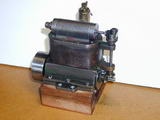
Expectations were rock-bottom that anyone would have a clue about last month's Watzit. I should have known better, and I should have circulated the images to The Boys before composing that entry as Uncle Eric knew it immediately! Well, maybe not the engine, as built, but certainly the engine as designed, and no wonder it had me thinking of steam engines. If you are curious, revisit the Twin Dalek entry (and I even managed to initially spell "Dalek" wrong—March was just not my month and don't mention the Boxter Bird Bath, created accidentally by leaving the thing outside overnight with the top down during one of the heaviest and longest rain storms of the past decade...)
Miles Marine
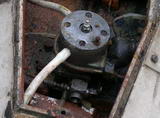
This photo arrived during the past month with a request for us to confirm its identity as a Miles of some sort. Our first reaction was, AAARRGGGHHH! But on sober contemplation, the engine has done precisely what its designer, Basil Miles, intended it to do, namely power a racing hydroplane in the 10cc category, so a certain amount of patina is to be expected. As an indirect result, photos of slightly better condition examples of the engine arrived and we've added a Miles 10cc Marine glow page. I'd been unaware that Basil Miles made engines this large, but it turns out he made engines even larger, which you can read about on the revised Basil Miles tribute page (and yes, the owner is going to refurbish his engine...)
Where Am I? Who Are All These People?

This image is a composite of the locations on the planet which have accessed the Model Engine News web site in the past six months, or so. A little while ago, we appealed for people who send us an email asking us to identify an engine, or ask for help of any kind, to please let us know where in the world they are located. To a gratifying extent, this may be working, or perhaps we're getting email from more thoughtful folk lately. Last week, we received a totally non-English text email where the sender thoughtfully added "Brazil", so we knew to run it through a Portuguese translator, though we'd probably have guessed that, eventually. So thanks to those who are now adding their location to their signature. Currently, our small group of grey-haired (and no-haired) wisdom reside in Australia, Canada, England, France, and the United States.
Interesting URLs

I'd like to offer thanks to those who take the time to send us links to things which we may find of interest, and which we may not have seen. April seems to have been a month for them so I'd like to pass on to readers the following links, or Universal Resource Locators (URLs) as we say in the trade.
Modern 2,5cc Team Race Glow plans from Romania (scroll to the bottom of the page). This is a Schnuerle ported, drum valve, twin ball race glow, with a stroke of 13.6mm and a bore of 15.2mm, for a capacity of 2.468cc (.151 cuin). Not something that could be made from barstock, but a fine collection of ideas.
2,806 downloadable model airplane plans with a nice assortment of ways to browse the list. They are drawn from old, and no so old magazines and kits, digitized and generally cleaned up by enthusiasts. The "Outerzone" acts as a searchable repository to which you can contribute. Anyone got the Veron Philibuster?
A "True" Diesel model engine, meaning one with injectors and all. The builder found a compression ratio of 21:1 was required to generate sufficient heat to combust the finly atomized fuel from the injector.
There was a Charlton!
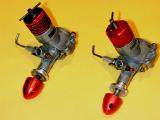
We received a delightful email from Mrs Christina Crosby last month. During the mid 1950's, Chris worked in the offices of model engine maker, Davis-Charlton Ltd, and has been able to provide us many helpful, additional facts about the company, including the surprise that there really was a Mr Charlton, and that he worked closely with Hefin ("Evan") Davies on the engine designs. Adrian has revised and updated our Davies-Charlton Story to include this information and other interesting items. Our gratitude to Chris, now 82, for providing this first-hand information is deep and sincere.
Spares for British Engines
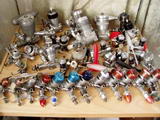
One of the most frequent type of email we get is the one which asks where the sender can get a needle valve for the old engine they've had since nineteen-fifty-mumble. Our standard response is to say find another engine of the same type, in even worse condition, which has the required part, or find a friendly model engineer who can make one at an acceptable price. Now there may be another answer for owners of marques like ED, DC, AM, Frog, Amco, Eflin, Mills, etc. Model Engine Spares (UK) offers parts and rebores at what seem reasonable prices. They will also post a "Wanted" on your behalf. We've had no contact with this company, so can't offer an endorsement, but their intent is sure good.
Atom Minor Again
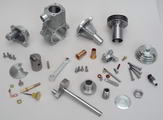
After telling the world last month that the drawings for ETW's Atom Minor Mk III were correct, I've had two emails letting me know that this is not quite the case and that the conrod between centers distance is incorrect (I've amended the article in question). One of our correspondents, Jan Huning, even had an original copy of the Atom Minor book, so we can now confirm the publisher was indeed Percival Marshal Ltd, and that the book first appeared in 1947. The photo here shows Jan's example of the engine, recently built using the castings provided by Hemingway Kits (UK). This has prompted me to take my own complete, but not runnable Atom Minor down from the shelf and begin making a new conrod. It has also prompted an Atom Minor Mk III page to document the dimension problem which exists in the TEE reprint book, and the full size plan (PE13), both dating back to 1947 at least.
New Books and Magazines This Month

Have you ever wondered why aircraft "taxi" when on the ground, or why Sopwith Aviation suddenly disappeared after the Great War of 1914-18? If so, you may enjoy reading our book of the month: Pure Luck: The Authorised Biography of Sir Thomas Sopwith, by Alan Bramson, Crecy Publishing Ltd, England, 2006, ISBN 978-0859791052. The book is available in hardback or paperback form and contains 288 pages with numerous black and white photos scattered through the text (ie, not "plates"). As you may have gathered from the title, it recounts the rather remarkable life of Sir Thomas Octave Murdoch (T.O.M.) Sopwith, one of the pioneers of flight.
Regular readers may have already gathered from past book reviews that I'm rather addicted to biographies of aviation related pioneers. Perhaps it's a failing of old age, but learning how all the little pieces fit together seems to give me a great deal of pleasure—for as long as I can remember what those pieces were. I'd guess that anyone who loves aeroplanes would have a passing knowledge of the types designed and used on all sides during the First World War. When it comes to naming a few of the British manufacturers, I'd have to further guess that "Sopwith" would head the list with their "Camel" being one of the most recognized types during the conflict. Yet after the war, Sopwith seemed to suddenly disappear; why?
In great detail (but without footnotes, or endnotes), Bramson's book tells how Tom Sopwith taught himself to fly in a Howard Wright Avis monoplane (no connection to the US Wright brothers) and on November 10, 1910, after just one crash, was awarded Aviator's Certificate No 31. This was not his first encounter with flight. In 1906 at the age of 18, he had bought and operated a hot air balloon, having earlier made several balloon flight in the company of one Charles Rolls (yes, that Rolls).
After gaining his Aviator's Certificate, Tom Sopwith decided to earn money by entering the numerous contests, races, trials etc which offered cash prizes. In this he was successful, gaining several records in the process, first in England, then the USA (where he attracted the ire and litigious leanings of the Wright Brothers and had to buy a Wright Model B to appease them). Returning to England cashed up, he opened a flying school at Brooklands where over the next two years, he taught many to fly, including one Major Hugh Trenchard (later known as the Father of the RAF), and a quiet Australian named Harry Hawker, who he had hired to assist with engine maintenance. In 1912, depressed at the standard of aircraft in England, he discussed making his own design with his chief mechanic, Fred Sigrist, and pilot prodigy, Harry Hawker. They took the engine from their Bleriot, the wings from a Burgess Wright (no relation) biplane, chalked out a closed fuselage on the floor of their Brooklands shed, and created what for the times appears to be a surprisingly modern contrivance which they named the "Hybrid", for obvious reasons. The Royal Navy bought the Hybrid and, buoyed by the sale, the three bought an ice skating rink for use as a factory and the Sopwith Aviation Company was born.
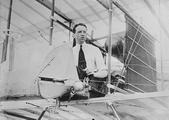
The rest should be history, and for a time it was. With the outbreak of war, England was desperate for aircraft to meet the "Fokker Scourge". Sopwith rose to the challenge with designs like the Pup, 1-1/2 Strutter, Camel, and Snipe. They also had a few less noteworthy craft, such as the Snail, and Rhino. Even the Sopwith Triplane was not a great success with only 152 built compared to 5,466 Strutters and 5,747 Camels. But the winners made up for the duds and in total, Sopwith manufactured some 18,000 aircraft during the 14-18 War, so what went wrong? Two things: the transition from war to peace and associated disinterest in aircraft, especially fighters, by the British Government, and a wondrously short-sighted decision by the British Treasury to demand repayment of "excess war profits". To protect his creditors, Sopwith placed the company in voluntary liquidation with an excess of assets over liabilities of some £279,120. That was 1920. In the same year, Sopwith, Hawker, Sigrist, and a new partner, VW Eyre (a sailing partner of Sopwith), put up £5,000 each to start a new company named "HG Hawker Engineering Co Ltd"—Harry Hawker having recently gained extensive public recognition for a flight across the Atlantic from west to east which nearly succeeded, ditching just short of the Irish coast—so the new firm's name capitalized on Hawker's name, and fame.
The author recounts the early tribulations of HG Hawker Engineering as they kept cash flowing by making motorcycles and spares for Sopwith aircraft, but sought aeroplane design and manufacture as their ultimate goal. Also detailed is Managing Director Sopwith's hiring of a young ex-aeromodeller called Sydney Camm. Camm, we should know, went on to design a few well known kites such as the Hawker Hart, Hind, Demon, Nimrod, Fury, Hurricane, Typhoon, Tempest, Sea Fury, Sea Hawk, Hunter, and Harrier, all under the overall management of Tom Sopwith. Also detailed, are Sopwith's canny acquisitions. Faced in 1963 with a name change and feeling that "Hawker Gloster deHavilland Avro Blackburn Armstrong Whitworth Aircraft Co Ltd" may be a trifle unwieldy on the firm's letterhead, "Hawker Siddeley Aviation" was adopted. This firm was to continue until 1977 when another British Government decided to nationalize the aircraft industry.
I've omitted a lot of ins and outs and exploits that are detailed in the book, such as Sopwith almost taking the America's Cup in 1934—quote of the day: Britannia rules the waves. but America waives the rules (p144). Through it all, Tom Sopwith comes across as a highly intelligent, softly spoken gentleman of extraordinary talent, with the ability to choose the right man for the job, then get out of his way. Being an authorised biography, the author had full access to Sir Tom (who died on January 27, 1989, just nine days after his 101st birthday), so the book contains a lot of quotes and anecdotes from Sopwith, Camm, and others. Typical of these is the following exchange which took place during Sopwith's 1934 America's Cup challenge:
"...I forget whether the race was won or lost—and I was very tired. And a motor launch came up alongside with a party of four or five people on board and a dog. And the fellow at the helm looked up at me and he said, "You Sopwith?" I said yes. He said, "I'm Fokker." I said, "Christ! Come on board and have a drink.""
Of the two questions I posed at the start of this review, you should now have an idea of why Sopwith aircraft disappeared—it didn't, just the name changed—but what of the other? Why do aircraft "taxi"? Well, according to our author, around 1910, motorized carriages began to replace horse-drawn cabs and some idiotic officials decided to name them "Taximeter-motor Cabriolets". One DG Gilmour, a noted aviation pioneer of the day, abbreviated the term and applied it to aircraft maneuvering on the ground. There being no dual control aircraft at that time, pilots under training were taught to "taxi" at increasing speed until they gained sufficient speed and confidence to chance a first take-off. Now you know.
I enjoyed Pure Luck enormously. It filled in many of the missing connecting puzzle pieces left by other biographies such as Not Much of an Engineer, Fedden, Slide Rule, Wolseley Radial Aero Engines, Sky Fever, and Genesis Of The Jet (Sopwith, through the Hawker Group, owned Gloster, who made the first British experimental jet aircraft and first operational jet fighter). The detail focuses more on the people than the machines, but there are enough details on the types to keep the technically oriented satisfied. Tables in the appendix give the numbers of all types built by Sopwith and all the other companies after they became part of the Hawker group. My copy was obtained, discounted, through Amazon and it gets the full five stars  .
.
Engine Of The Month: CS "Oliver" Twin
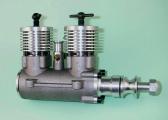
It's not often we feature a "new", or even a current model engine as Engine of the Month because, well to be honest, most of them are rather boring! There are always exceptions and we think this month's subject is quite interesting: the CS OT Twin. We've called it the "Oliver" Twin because it uses components from the CS Oliver Tiger replica, though it is not like any engine ever made by the Olivers in any but most general terms. We are also lucky in that examples of the engine were obtained by Adrian Duncan (Canada), and Maris Dislers (Australia). Both are very experienced engine men, which is just as well as both had to re-make parts to restore their OT Twins to running condition after experiencing different types of catastrophic infant mortality with their examples of the engine. Despite that, both like the engine and Adrian offers some sage advice to would-be owners intending to do more than just look at it.
We can only hope sincerely that their observations find their way back to CS and are acted upon, especially since just as we were about to go to press, another owner experienced a failure of the "spool", which Adrian had predicted as a distinct possibility. CS is repairing this engine at no charge, except for the bother and cost of mailing it back to the factory.
Tech Tip of the Month
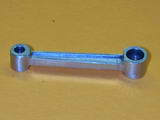
As mentioned above, the between centers dimension given for the conrod in the construction booklet for Edgar T Westbury's Atom Minor Mk III is incorrect. However, if you follow ETW's text relating to making the conrod, the dimension mistake becomes totally irrelevant! This is because he advocates making the rod length such that the piston crown at bottom dead center (BDC), is level with the bottom of the exhaust ports:
In the home construction of engines, slight errors of dimensions of the various parts may produce a cumulative discrepancy affecting the position of the piston in the cylinder, and therefore the port timing. To avoid any trouble from this cause, it is my invariable practice to check up by using a temporary or "dummy" connecting-rod, made by drilling two holes in any odd strip of material, before making the permanent rod. The piston should just uncover the exhaust port fully at bottom dead centre; if the trial with the dummy rod shows that it travels too far down, or not far enough, the difference can be noted, and the distance between the bearings altered to suit when making the rod. Other ways of correcting the discrepancy have been referred to.
p 32
As usual, we have to agree that ETW knows his stuff, and knew the various problems which home constructors were likely to cause themselves. There are limits however, and gross cumulative errors may have other consequences, such as the piston skit coming into contact with things it shouldn't at BDC! But generally, if your exhaust and transfer ports are correct in relation to each other and not more than say 0.020 (0.5mm) or so out on an engine like the Atom, ETW's method will be the way to go. As size reduces, so does the allowable error. Overall, work as closely to dimensions as possible, but remember that small errors can be corrected using the method described by Westbury.
As a parting note, you can approximate the required conrod length by using the given dimensions to sketch out the heights of the cylinder top rim, crankpin axis, and wrist pin axis, all relative to the crankshaft axis for the engine at TDC with the piston crown level with the cylinder top, as shown in the General Arrangement on page 48 of the booklet. I say "approximate" because this is a Desax engine and so the crankpin will not be at the top of throw at the point when the piston is at TDC. The difference is tiny though (I calculate less than 0.001"), but for purists, it is something to be mindful of.
Deprecated

In the programming world, when a method or function in a programming language is "deprecated", this means that you should no longer use it because it has been replaced by something else and while it may still work, it may be deleted altogether at some time in the future. During the past month, I noticed that this had happened to the ereg function of PHP which is used on this web site to calculate and display timing diagrams. In fact, it had gone to the extreme and the function had disappeared entirely as of PHP 5.3 and parts of our timing calculator were no longer working. I've fixed the ereg problem, but while the numbers are generated ok, "something" has killed off the nice little graphic arcs that should appear. As this was found on the last day of the month, that problem still exists, but I'm "on it"...
Briefly Noted
This section is intended to alert you to little things that are hard to expand to a full news item, or cunningly wind into the Editorial, but are worthy of note never the less.
- Somehow, the TOP Engine series got left out of the Engine Finder. All fixed now.
- Pete Engel has sent in a photo of his stick 'n tissue Cleveland P61 Black Widow in it's final form, which is sans tissue 'cause it would be a crime to cover it. See Page 9 of the Engine Gallery.
- We've fixed a (ahem) minor problem with the Elmer Wall Tribute Page, so all images should now display ok.
- Thanks to the eagle eyed reader (yes, you, Maris) who spotted the deliberate mistake on the How To Tighten Head Bolts page. An image has been added at the end to clarify what I meant when I said the opposite—all fixed now.
 Unexpected!
Unexpected!
 Miles Marine
Miles Marine
 Where Am I? Who Are All These People?
Where Am I? Who Are All These People?
 Interesting URLs
Interesting URLs
 There was a Charlton!
There was a Charlton!
 Spares for British Engines
Spares for British Engines
 Atom Minor Again
Atom Minor Again
 Deprecated
Deprecated
 Editorial
Editorial
 New Books and Magazines This Month
New Books and Magazines This Month
 Engine Of The Month: CS "Oliver" Twin
Engine Of The Month: CS "Oliver" Twin
 Tech Tip of the Month
Tech Tip of the Month
 Briefly Noted
Briefly Noted
 Standard Stuff
Standard Stuff


 . And last but not least, next month, June 2012, will be our tenth anniversary of the "monthly" MEN format. Expect something a bit special...
. And last but not least, next month, June 2012, will be our tenth anniversary of the "monthly" MEN format. Expect something a bit special...









 .
.


